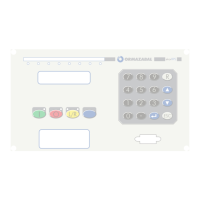IG-150-EN version 04; 03/10/16
62
Protection functions. Description and settings General instructions
ekor.rps
Trip permission without V
pol
(Directional Locking on the
display). If it is set as YES allows the overcurrent trip if the
polarization voltage is lower than the minimum polarization
voltage; if it is set as NO in those conditions the overcurrent
trip is not allowed.
Phase zone width and neutral zone width. They are settings
that show the angle that the trip zone of the phase and
neutral units will respectively cover. That is, if the maximum
torque line is set to 0° and the pick up zone width is set to
70° the relay will trip between + 35° y - 35°. This zone has
to be added 5° at each side to obtain the locking zone. In
this zone the relay maintains the last state in which it was
(front or back). That is, if it comes from a trip zone, this trip
is maintained until the locking zone is crossed. If it comes
from a non-trip zone it is maintained without tripping until
crossing that zone.
If, for example, is wished that the tripping zone be between
- 45° y + 135°, the “setting angle” must be set in 45° and the
“covered angle” in 180°.
4.6.1. Phase directional in quadrature (67)
Operation
For the phase directionality detection, the polarization
voltage is the one corresponding to the connection in
quadrature (90°), where each phase current is compared
with the compound voltage between the other two phases.
It works as three single-phase units in which the polarization
voltages are the voltages composed by the healthy phases.
These voltages are obtained through calculation or through
transformer measurement depending if the setting voltage
type shows that the introduced signals are simple voltages
(calculation) or compound (measurement).
In case the phase order ABC is polarized with V
ab
, V
bc
and V
ca
against I
c
, I
a
, and I
b
. In case the phases order CBA is polarized
with V
ba
, V
cb
and V
ac
against I
c
, I
a
and I
b
.
There is a 5
th
zone between the locking zone and the trip
zone, for which the present directional status is maintained.
1
2
3
4
VA
I
a
V
bc
VC
VC
LMP
5°
5°
1
Locking zone
2
Trip zone
3
90 - Setting angle
4
Angle covered by trip zone
Figure 4.4. Phase directional
Memory
It is polarized by the positive sequence voltage while it is
higher than a threshold. If the voltage is lower than this
value it is polarized by means of the voltage memorized
2cycles before disappearing the voltage. This memorization
is maintained 0.5 s.
Trip permission without V
pol
(directional locking on the
display)
This setting is used when the polarization voltage falls
below a threshold (polarization V setting), so that if it is set
as YES, it indicates forwards (trip permission) and if it is set
as NO, it indicates reverse (no permission).
The memory treatment has been previously done.
Signaling
It provides forward and reverse signaling per phase.
Being the trip Permission without V
pol
(Directional Locking)
set as NO if the polarization magnitudes are below the
threshold, the direction is not signaled.
Being the trip Permission without V
pol
(Directional Locking)
set as YES if the polarization magnitudes are below the
threshold, it signals reverse and forward.

